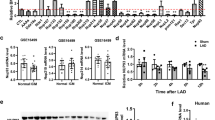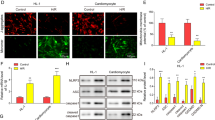Abstract
Acute myocardial infarction (AMI) is a life-threatening disease that often results in heart failure. CRYAB, a small heat shock protein, has been shown to have cardioprotective effects against oxidative stress-induced apoptosis in AMI. Previously, we purified a peptide derived from CRYAB (LEDQFFGEH), which we named PDFC. In this study, we determined the function of PDFC on HL-1 cardiomyocytes and explored the mechanism underlying its function. A hypoxic myocardiocyte cell line was generated by stimulation of HL-1 mouse cardiac muscle cells with different concentrations of CoCl2. Then, the hypoxic HL-1 cells were treated with the synthetic PDFC peptide, and cell proliferation, migration, and apoptosis were assessed to examine the effects of PDFC on HL-1 and hypoxic HL-1 cells. To examine the mechanism underlying the effects of PDFC on hypoxic cells, PDFC-treated hypoxic HL-1 cells were submitted for deep RNA sequencing. Finally, several differentially expressed genes in different pathways were selected for confirmation by RT-qPCR. Hypoxic myocardiocytes were generated by stimulating HL-1 cells with 800 µM CoCl2 for 24 h, which significantly upregulated HIF-1α. PDFC at 200 µg/ml showed the most positive effects on cell viability. Although hypoxic HL-1 cells and PDFC-treated hypoxic HL-1 cells both showed lower viability and migration and higher levels of apoptosis than untreated HL-1 cells, compared to hypoxic HL-1 cells, PDFC-treated hypoxic HL-1 cells showed higher viability and migration and lower apoptosis. The deep sequencing showed that 812 genes were upregulated and 1946 genes were downregulated. Among these differentially expressed genes, 699 of the upregulated genes and 1488 of the downregulated genes were protein-coding genes. Gene ontology and pathway enrichment analysis showed that the downregulated genes were dominant and that the PI3K-Akt pathway was located in the center of the network. A protein–protein interaction network was constructed, and 892 nodes were determined. In PDFC-treated hypoxic HL-1 cells, Fn1, Pik3r5, and Creb5 were downregulated, while Insr, Bcl2, Mapk14, and Pten were upregulated when compared to the levels in hypoxic HL-1 cells. In conclusion, this study reveals the significant bioactive effect of the CRYAB-derived peptide, PDFC on cardiomyocytes and the underlying mechanism.







Similar content being viewed by others
References
Sacks NC, Ash AS, Ghosh K, Rosen AK, Wong JB, Rosen AB (2015) Trends in acute myocardial infarction hospitalizations: are we seeing the whole picture? Am Heart J 170:1211–1219
Plakht Y, Shiyovich A, Gilutz H (2015) Predictors of long-term (10-year) mortality postmyocardial infarction: age-related differences. Soroka acute myocardial infarction (SAMI) project. J Cardiol 65:216–223
Shahzad S, Hasan A, Faizy AF, Mateen S, Fatima N, Moin S (2018) Elevated DNA damage, oxidative stress, and impaired response defense system inflicted in patients with myocardial infarction. Clin Appl Thromb Hemost 24:780–789
Ahmad G, Agarwal A, Esteves SC et al (2017) Ascorbic acid reduces redox potential in human spermatozoa subjected to heat-induced oxidative stress. Andrologia 49:e12773
Circu ML, Aw TY (2010) Reactive oxygen species, cellular redox systems, and apoptosis. Free Radical Biol Med 48:749–762
Dimauro I, Antonioni A, Mercatelli N, Caporossi D (2018) The role of alphaB-crystallin in skeletal and cardiac muscle tissues. Cell Stress Chaperones 23:491–505
Kamradt MC, Chen F, Cryns VL (2001) The small heat shock protein alpha B-crystallin negatively regulates cytochrome c- and caspase-8-dependent activation of caspase-3 by inhibiting its autoproteolytic maturation. J Biol Chem 276:16059–16063
Morrison LE, Hoover HE, Thuerauf DJ, Glembotski CC (2003) Mimicking phosphorylation of alphaB-crystallin on serine-59 is necessary and sufficient to provide maximal protection of cardiac myocytes from apoptosis. Circ Res 92:203–211
Mao YW, Liu JP, Xiang H, Li DW (2004) Human alphaA- and alphaB-crystallins bind to Bax and Bcl-X(S) to sequester their translocation during staurosporine-induced apoptosis. Cell Death Differ 11:512–526
Xu F, Yu H, Liu J, Cheng L (2013) AlphaB-crystallin regulates oxidative stress-induced apoptosis in cardiac H9c2 cells via the PI3K/AKT pathway. Mol Biol Rep 40:2517–2526
Maloyan A, Sanbe A, Osinska H, Westfall M, Robinson D, Imahashi K, Murphy E, Robbins J (2005) Mitochondrial dysfunction and apoptosis underlie the pathogenic process in alpha-B-crystallin desmin-related cardiomyopathy. Circulation 112:3451–3461
Bullard B, Ferguson C, Minajeva A et al (2004) Association of the chaperone alphaB-crystallin with titin in heart muscle. J Biol Chem 279:7917–7924
Rajasekaran NS, Connell P, Christians ES et al (2007) Human alpha B-crystallin mutation causes oxido-reductive stress and protein aggregation cardiomyopathy in mice. Cell 130:427–439
Fouillen L, Petruzziello F, Veit J, Bhattacharyya A, Kretz R, Rainer G, Zhang X (2013) Neuropeptide alterations in the tree shrew hypothalamus during volatile anesthesia. J Proteom 80:311–319
Rahman MM, Neupert S, Predel R (2013) Neuropeptidomics of the Australian sheep blowfly Lucilia cuprina (Wiedemann) and related Diptera. Peptides 41:31–37
Faridi P, Aebersold R, Caron E (2016) A first dataset toward a standardized community-driven global mapping of the human immunopeptidome. Data Brief 7:201–205
Ray PS, Martin JL, Swanson EA, Otani H, Dillmann WH, Das DK (2001) Transgene overexpression of alphaB crystallin confers simultaneous protection against cardiomyocyte apoptosis and necrosis during myocardial ischemia and reperfusion. FASEB J 15:393–402
Adhikari AS, Singh BN, Rao KS, Rao ChM (2011) alphaB-crystallin, a small heat shock protein, modulates NF-kappaB activity in a phosphorylation-dependent manner and protects muscle myoblasts from TNF-alpha induced cytotoxicity. Biochem Biophys Acta 1813:1532–1542
Wu L, Li H, Li X, Chen Y, Zhang Q, Cheng Z, Fan Y, Qian L, Song G (2017) Peptidomic analysis of cultured cardiomyocytes exposed to acute ischemic-hypoxia. Cell Physiol Biochem 41:358–368
Cheng CI, Lee YH, Chen PH, Lin YC, Chou MH, Kao YH (2017) Cobalt chloride induces RhoA/ROCK activation and remodeling effect in H9c2 cardiomyoblasts: Involvement of PI3K/Akt and MAPK pathways. Cell Signal 36:25–33
Robinson MD, McCarthy DJ, Smyth GK (2010) edgeR: a Bioconductor package for differential expression analysis of digital gene expression data. Bioinformatics 26:139–140
Yu G, Wang LG, Han Y, He QY (2012) ClusterProfiler: an R package for comparing biological themes among gene clusters. OMICS 16:284–287
Shannon P, Markiel A, Ozier O, Baliga NS, Wang JT, Ramage D, Amin N, Schwikowski B, Ideker T (2003) Cytoscape: a software environment for integrated models of biomolecular interaction networks. Genome Res 13:2498–2504
Bader GD, Hogue CW (2003) An automated method for finding molecular complexes in large protein interaction networks. BMC Bioinform 4:2
Chen R, Xu J, She Y, Jiang T, Zhou S, Shi H, Li C (2018) Necrostatin-1 protects C2C12 myotubes from CoCl2-induced hypoxia. Int J Mol Med 41:2565–2572
Xie MJ, Chang H, Wang YY, Zhang L, Song Z, Guo WG, Wang T, Che HL, Yu ZB (2010) Evidence that apoptotic signalling in hypertrophic cardiomyocytes is determined by mitochondrial pathways involving protein kinase Cdelta. Clin Exp Pharmacol Physiol 37:1120–1128
Griffiths ER, Friehs I, Scherr E, Poutias D, McGowan FX, Del Nido PJ (2010) Electron transport chain dysfunction in neonatal pressure-overload hypertrophy precedes cardiomyocyte apoptosis independent of oxidative stress. J Thorac Cardiovasc Surg 139:1609–1617
Choudhury S, Bae S, Kumar SR, Ke Q, Yalamarti B, Choi JH, Kirshenbaum LA, Kang PM (2010) Role of AIF in cardiac apoptosis in hypertrophic cardiomyocytes from Dahl salt-sensitive rats. Cardiovasc Res 85:28–37
Riba A, Deres L, Eros K, Szabo A, Magyar K, Sumegi B, Toth K, Halmosi R, Szabados E (2017) Doxycycline protects against ROS-induced mitochondrial fragmentation and ISO-induced heart failure. PLoS ONE 12:e0175195
Li DW, Liu JP, Mao YW et al (2005) Calcium-activated RAF/MEK/ERK signaling pathway mediates p53-dependent apoptosis and is abrogated by alpha B-crystallin through inhibition of RAS activation. Mol Biol Cell 16:4437–4453
Zhu Z, Li R, Stricker R, Reiser G (2015) Extracellular alpha-crystallin protects astrocytes from cell death through activation of MAPK, PI3K/Akt signaling pathway and blockade of ROS release from mitochondria. Brain Res 1620:17–28
King AM, MacRae TH (2015) Insect heat shock proteins during stress and diapause. Annu Rev Entomol 60:59–75
Tang S, Yin B, Song E, Chen H, Cheng Y, Zhang X, Bao E, Hartung J (2016) Aspirin upregulates alphaB-Crystallin to protect the myocardium against heat stress in broiler chickens. Sci Rep 6:37273
Mitra A, Basak T, Datta K, Naskar S, Sengupta S, Sarkar S (2013) Role of alpha-crystallin B as a regulatory switch in modulating cardiomyocyte apoptosis by mitochondria or endoplasmic reticulum during cardiac hypertrophy and myocardial infarction. Cell Death Dis 4:e582
Kamradt MC, Chen F, Sam S, Cryns VL (2002) The small heat shock protein alpha B-crystallin negatively regulates apoptosis during myogenic differentiation by inhibiting caspase-3 activation. J Biol Chem 277:38731–38736
Brady JP, Garland DL, Green DE, Tamm ER, Giblin FJ, Wawrousek EF (2001) AlphaB-crystallin in lens development and muscle integrity: a gene knockout approach. Invest Ophthalmol Vis Sci 42:2924–2934
See F, Thomas W, Way K, Tzanidis A, Kompa A, Lewis D, Itescu S, Krum H (2004) p38 mitogen-activated protein kinase inhibition improves cardiac function and attenuates left ventricular remodeling following myocardial infarction in the rat. J Am Coll Cardiol 44:1679–1689
Yang J, Wu S, Zhu L, Cai J, Fu L (2017) Hydrogen-containing saline alleviates pressure overload-induced interstitial fibrosis and cardiac dysfunction in rats. Mol Med Rep 16:1771–1778
Yamamoto S, Yamashita A, Arakaki N, Nemoto H, Yamazaki T (2014) Prevention of aberrant protein aggregation by anchoring the molecular chaperone alphaB-crystallin to the endoplasmic reticulum. Biochem Biophys Res Commun 455:241–245
den Engelsman J, Bennink EJ, Doerwald L, Onnekink C, Wunderink L, Andley UP, Kato K, de Jong WW, Boelens WC (2004) Mimicking phosphorylation of the small heat-shock protein alphaB-crystallin recruits the F-box protein FBX4 to nuclear SC35 speckles. Eur J Biochem 271:4195–4203
Zhu ZR, He Q, Wu WB, Chang GQ, Yao C, Zhao Y, Wang M, Wang SM (2018) MiR-140-3p is involved in in-stent restenosis by targeting C-Myb and BCL-2 in peripheral artery disease. J Atheroscler Thromb 25:1168–1181
Ye Q, Tian GP, Cheng HP et al (2018) MicroRNA-134 promotes the development of atherosclerosis via the ANGPTL4/LPL pathway in apolipoprotein E knockout mice. J Atheroscler Thromb 25:244–253
Long B, Li N, Xu XX, Li XX, Xu XJ, Guo D, Zhang D, Wu ZH, Zhang SY (2018) Long noncoding RNA FTX regulates cardiomyocyte apoptosis by targeting miR-29b-1-5p and Bcl2l2. Biochem Biophys Res Commun 495:312–318
Wang N, Feng Y, Xu J, Zou J, Chen M, He Y, Liu H, Xue M, Gu Y (2018) miR-362-3p regulates cell proliferation, migration and invasion of trophoblastic cells under hypoxia through targeting Pax3. Biomed Pharmacother 99:462–468
Li W, Liang J, Zhang Z, Lou H, Zhao L, Xu Y, Ou R (2017) MicroRNA-329-3p targets MAPK1 to suppress cell proliferation, migration and invasion in cervical cancer. Oncol Rep 37:2743–2750
Fuentes N, Roy A, Mishra V, Cabello N, Silveyra P (2018) Sex-specific microRNA expression networks in an acute mouse model of ozone-induced lung inflammation. Biol Sex Differ 9:18
Vegter EL, Ovchinnikova ES, Sillje HHW et al (2017) Rodent heart failure models do not reflect the human circulating microRNA signature in heart failure. PLoS ONE 12:e0177242
Pande M, Bondy ML, Do KA, Sahin AA, Ying J, Mills GB, Thompson PA, Brewster AM (2014) Association between germline single nucleotide polymorphisms in the PI3K-AKT-mTOR pathway, obesity, and breast cancer disease-free survival. Breast Cancer Res Treat 147:381–387
Zhang M, Li Y, Wang H, Yu W, Lin S, Guo J (2018) LncRNA SNHG5 affects cell proliferation, metastasis and migration of colorectal cancer through regulating miR-132–3p/CREB5. Cancer Biol Ther 20(4):524–536
Riehle C, Abel ED (2016) Insulin signaling and heart failure. Circ Res 118:1151–1169
Bi YM, Wu YT, Chen L et al (2018) 3,5-Dicaffeoylquinic acid protects H9C2 cells against oxidative stress-induced apoptosis via activation of the PI3K/Akt signaling pathway. Food Nutr Res. https://doi.org/10.29219/fnr.v62.1423
Acknowledgements
This study was supported by Natural Science Foundation of China (Grant No. 81601297).
Author information
Authors and Affiliations
Corresponding authors
Ethics declarations
Conflict of interest
The authors declare they have no conflict of interest.
Additional information
Publisher's Note
Springer Nature remains neutral with regard to jurisdictional claims in published maps and institutional affiliations.
Rights and permissions
About this article
Cite this article
Hu, X., Liu, H., Li, M. et al. Transcriptomic analysis reveals the role of a peptide derived from CRYAB on the CoCl2-induced hypoxic HL-1 cardiomyocytes. J Thromb Thrombolysis 51, 265–276 (2021). https://doi.org/10.1007/s11239-020-02117-4
Published:
Issue Date:
DOI: https://doi.org/10.1007/s11239-020-02117-4




